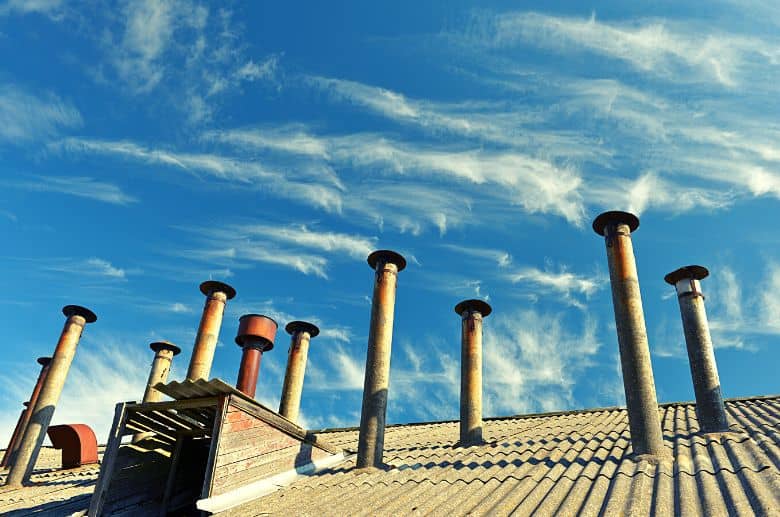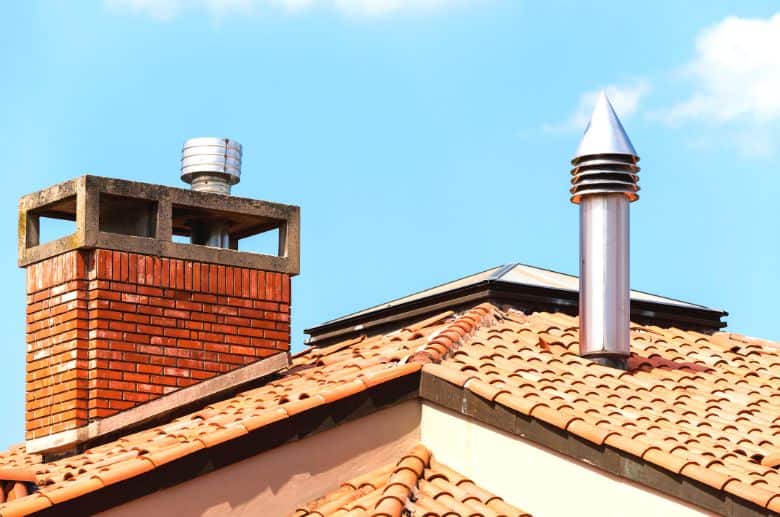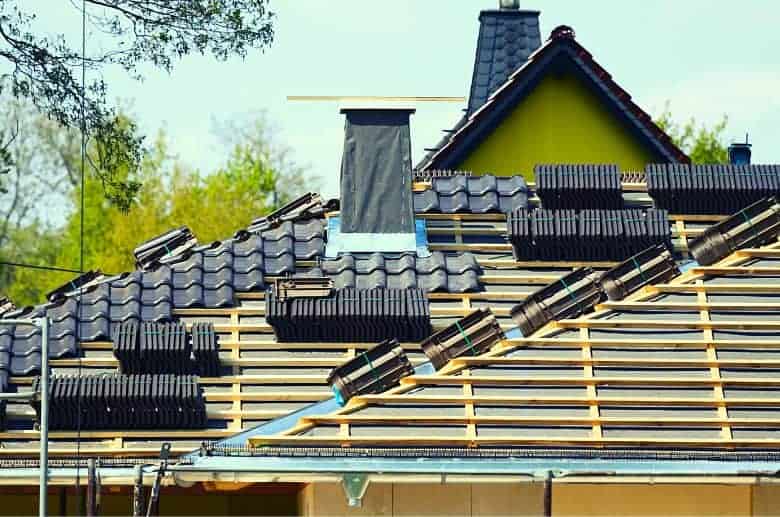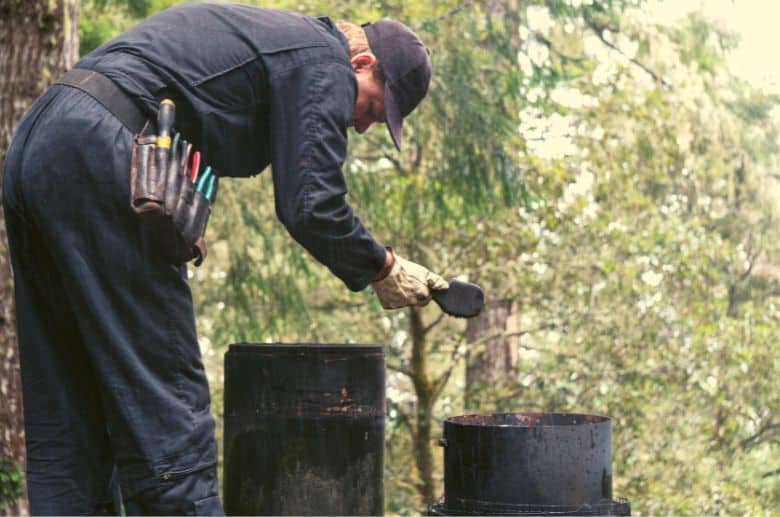Chimneys remove smoke and dangerous gasses from your home, preventing them from causing health problems.
When you think of a chimney, the image that comes to mind is usually a masonry chimney with a brick stack. But there’s another type of chimney that has gained popularity over the past few years – the metal chimney.
Chimneys are an expensive investment that leaves many homeowners wondering, are metal chimneys safe to use?
Unlike masonry chimneys, these chimneys are flexible and do not affect the structural integrity of your home.
In this post, we will discuss the differences between a metal and brick chimney and answer all the questions you need to know about a metal chimney.
Keep reading to learn more about metal chimneys!
Types of metal chimneys

A metal chimney rarely poses a structural threat to your home if your fireplace is upstairs. This is because it is lightweight, making it a safe option for your property. Let’s take a look at the different types of metal chimneys.
- System Chimneys – The components of system chimneys are factory-built. They are connected on-site.
- Custom-built chimneys – These are installed on-site using factory-built liners.
- Connecting flue pipes – These pipes connect the chimney or flue to the appliance.
Masonry Chimney vs Metal Chimney
Let’s take a look at the differences between a metal chimney and a masonry chimney:
| Features | Metal Chimney | Masonry chimney |
| Safety | Safer than brick chimneys; easy to install, can handle high temperatures well | Built on-site, not advisable to build beyond the second floor. Soot and creosote tend to accumulate |
| Efficiency | Not great at heat reflection | Great at heat reflection-better at warming the home than a metal chimney |
| Cleaning and maintenance | Easy to clean and maintain. Few water damage issues. | Brick and mortar deteriorates over time, prone to water damage if not well-maintained |
| Aesthetic appeal | Looks great on various homes. The stack can be encased in different materials | Gives your home a classic look |
| Increased Resale Value | Easy to maintain. Doesn’t need rebuilding when you want to sale | May require extensive repairs if you want to sell your home |
| Life expectancy | Around 20-30 years | 50-100 years if well taken care of |
| Cost | Installation cost is $625-$7000 on average | Costs around $4000-$8000 to install |
Let’s expound on the features in the table above:

Safety
Compared to brick chimneys, metal chimneys are safer. One of the main safety features of stainless steel chimneys is the resistance to chimney fires caused by soot build-up.
Stainless steel can withstand high temperatures, and you will not have to deal with extensive damage in case of a chimney fire.
Also, unlike brick chimneys, metal chimneys do not crack, break or collapse when there are seismic movements. This means the liner won’t be affected in any way. Also, the water cannot seep through the metal and cause damage. Prefab chimneys with wood sidings have metal chase covers that prevent water from getting into the chimney.
Brick chimneys pose structural problems. It’s not advisable to install them beyond the second floor as it could affect the structure of your home.
Another issue with brick chimneys is that it is prone to breaks and cracks in areas that experience frequent seismic movements.
Also, soot and creosote tend to build up in brick chimneys. If there is a chimney fire, the damage will likely be extensive, and homeowners will have to incur huge repair or rebuilding fees.
——
Do You Need to Hire Chimney & Fireplace Expert?
Get free quotes from qualified experts near you. No commitment required!
——
Efficiency
Metal chimneys are not great at heat reflection. This means you will have problems keeping your room warm during the cold months.
On the other hand, a brick chimney provides good heat reflection, enabling the heat from the fireplace to warm up the entire room.
This feature comes in handy during the winter season. In addition, brick chimneys are more efficient at removing toxic gasses and smoke from the fireplace.
Cleaning and maintenance
Stainless steel metal chimneys are acid-resistant. Combustion gasses moving up the flue can mix with moisture and form acids that can erode the lining.
These acids cannot accumulate on stainless steel. Similarly, soot and creosote cannot accumulate on stainless steel.
Furthermore, stainless steel doesn’t deteriorate like brick and mortar when exposed to weather elements like rain. You can use a soft brush to clean the inside of the chimney.
The stacks in brick chimneys are usually exposed to weather elements like rain that cause the brick and mortar to deteriorate, eventually allowing water into the chimney.
Water damage issues include spalling bricks and weakened chimney structures. Also, soot and creosote accumulate in the flue over time, leading to dangerous fires and reducing the chimney’s efficiency.
Aesthetic appeal

When you picture a chimney, a brick chimney always comes to mind. Brick chimneys look great, especially if the bricks match other parts of your home, like the walls or patio.
Metal chimneys are visually appealing as well. You can cover the stack with wood siding matching your home. This gives it a classic look.
Alternatively, you can cover the flue pipe with stone or brick to make it look like traditional chimneys.
Increased Resale Value
Metal chimneys are low maintenance and easy to clean. When you want to sell your home, you can always list the chimney as one of the attractive items.
On the other hand, brick chimneys deteriorate over time.
The mortar joints begin to crack, and the structure can lean if there is a lot of water damage. This means the next homeowner will need to do repairs or rebuild the whole unit.
Life-expectancy
A prefabricated chimney can last anywhere between 20-30 years. You must keep it in great condition to ensure it stays this long. The life expectancy of a brick chimney is higher – it can last between 50-100 years as long as you schedule annual chimney inspections and cleaning.
Cost
Metal chimney installation costs $625-$7000, with the national average being $2500.
On the other hand, installing a brick chimney costs approximately $4000-$8000. As you can see, metal chimneys are a cost-effective option.
——
Do You Need to Hire Chimney & Fireplace Expert?
Get free quotes from qualified experts near you. No commitment required!
——
Can you replace a brick chimney with a metal chimney?
Over time, brick chimneys deteriorate and may require extensive repairs to restore their original state. Instead of doing these repairs, you can replace your brick chimney with a metal chimney.
Why would you replace your brick chimney? Here are some reasons:
- The flue allows smoke and dangerous gasses like carbon monoxide into your home.
- When you install a smaller insert or appliance into the existing chimney.
- If you convert the heating system from solid fuel to gas or oil, the flue becomes too big for it.
- The flue is rough or eroded. This causes frictional resistance to the flow of gasses and causes drafting issues
You can tear down the part of the chimney stack that has experienced the most damage. Next, install the stainless steel lining.
Ensure the chimney liner is the right size, so your new heating system works well. Remember, this is not a simple DIY job. Use a professional chimney sweep to install your new metal chimney.

Do prefabricated metal chimneys need cleaning?
Over time, soot and creosote accumulate in prefabricated chimneys. These combustion byproducts can trigger chimney fires if they become thicker than a quarter of an inch.
High amounts of heat can reduce the lifespan of a metal chimney, so it’s crucial that they are cleaned regularly.
Another reason to clean your metal chimney is that some home insurance companies require proof of chimney cleaning to keep your house insured.
Do metal chimney flues need cleaning?
Many issues could arise if you don’t clean your chimney metal flue. The first is the accumulation of soot and creosote. Secondly, soot and creosote are also acidic and can corrode the flue lining and cause holes and cracks. This will reduce the efficiency of your chimney. So, it would be best if you cleaned your chimney flue often.
How often should a metal chimney be cleaned?

Regularly cleaning your metal chimney ensures your fireplace functions efficiently, and you never have to deal with drafting issues. We recommend cleaning a metal chimney annually to keep it in excellent condition.
How long does a metal chimney last?
Metal chimneys last 20-30 years on average. There are two ways to improve the lifespan of a factory-built chimney.
One is to follow the manufacturer’s instructions on installing and maintaining the chimney. Secondly, you need to schedule annual chimney sweep cleaning and inspection to ensure issues are fixed early and your chimney is in great condition.
How much does it cost to replace a brick chimney with a metal chimney?
Installing a metal chimney costs between $4000 and $10000. The price covers the demolition of the brick chimney (around $500-$3500) and the installation of the factory-built chimney.
Conclusion
Metal or factory-built chimneys are cost-effective as they don’t require much maintenance like brick ones. If you are considering installing one, contact a certified chimney sweep to help you out.






